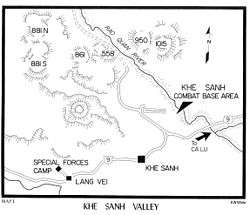Hill 950
| Hill 950 | |
|---|---|
|
Map showing location of U.S. bases around the Khe Sanh area | |
| Coordinates | 16°41′19″N 106°43′30″E / 16.6885°N 106.725°E |
| Type | Marines/Army |
| Site history | |
| Built | 1966 |
| In use | 1966-71 |
| Battles/wars |
Vietnam War Battle of Khe Sanh |
| Garrison information | |
| Occupants |
3rd Marine Division MACV-SOG |
Hill 950 (also known as Hickory Hill Mission Support Site, Hickory Hill MSS, Hickory Hill Radio Relay Site or Lemon Tree) was a U.S. Marine Corps and MACV-SOG base located north of Khe Sanh, in Quảng Trị Province.
History
The base was located approximately 3.5 km north of Khe Sanh.[1]
The base was first established by the Marines in late 1966.[2] In May 1967 the site was defended by a company from the 1st Battalion, 26th Marines. On the morning of 6 June a People's Army of Vietnam (PAVN) force attacked the base, but were forced back for the loss of 6 Marines and 10 PAVN killed.[3] CPL John Roland Burke would be posthumously awarded the Navy Cross for his actions during the battle.
In September 1969 as part of Operation Keystone Cardinal the 4th Marines abandoned the base as part of the withdrawal of the 3rd Marine Dvision from Vietnam.[4]
The base was later used as an operations base and radio relay site to allow SOG teams to remain in contact while on operations in Laos and to monitor sensors emplaced on the Ho Chi Minh Trail.[1] The base also housed the Army Security Agency's (ASA) Explorer VHF automated interception system linked to the Phu Bai Combat Base.[5]
On the morning of 4 June 1971 a PAVN force on Hill 1015 attacked the base with small arms and mortars.[5]:357 Four wounded U.S. servicemen, including the base commander and several Bru commandos were evacuated by helicopter at midday on 4 June. The helicopter was hit by PAVN fire and had to make an emergency landing and the occupants were transferred to another helicopter. Additional helicopters arrived at the base to evacuate U.S. personnel, but SGT Jon R. Cavaiani and SGT Robert Jones chose to remain to defend the base with some 20 Bru.[5]:359 The top-secret Explorer system was destroyed with thermal charges as the base was evacuated.[5]:362 On the morning of 5 June the PAVN launched a final assault, overrunning the base, while many of the Bru managed to escape, Cavaianai and Jones held out in a bunker until Jones was killed and Cavaiani was taken prisoner.[5]:360 SGT Cavaiani was released in April 1973, he would be awarded the Medal of Honor for his actions in the battle.[6]
Current use
The base has reverted to jungle.
See also
References
- 1 2 Kelley, Michael (2002). Where we were in Vietnam. Hellgate Press. pp. 5–219. ISBN 978-1555716257.
- ↑ Shulimson, Jack (1997). U.S. Marines in Vietnam: 1968 The Defining Year. History and Museums Division, Headquarters, U.S. Marine Corps. p. 60. ISBN 0-16-049125-8.
- ↑ Telfer, Gary (1984). U.S. Marines in Vietnam: Fighting the North Vietnamese 1967. History and Museums Division, Headquarters, U.S. Marine Corps. p. 46. ISBN 978-1494285449.
- ↑ Smith, Charles (1988). U.S. Marines in Vietnam: High Mobility and Standdown 1969. History and Museums Division, Headquarters, U.S. Marine Corps. p. 152. ISBN 978-1494287627.
- 1 2 3 4 5 Long, Lonnie (2013). Unlikely Warriors: The Army Security Agency's Secret War in Vietnam 1961-1973. iUniverse. p. 355. ISBN 9781475990591.
- ↑ "Jon R. Cavaiani dies at 70; Medal of Honor recipient from Vietnam War". Washington Post. 2 August 2014. Retrieved 2 January 2015.
![]() This article incorporates public domain material from websites or documents of the United States Marine Corps.
This article incorporates public domain material from websites or documents of the United States Marine Corps.
